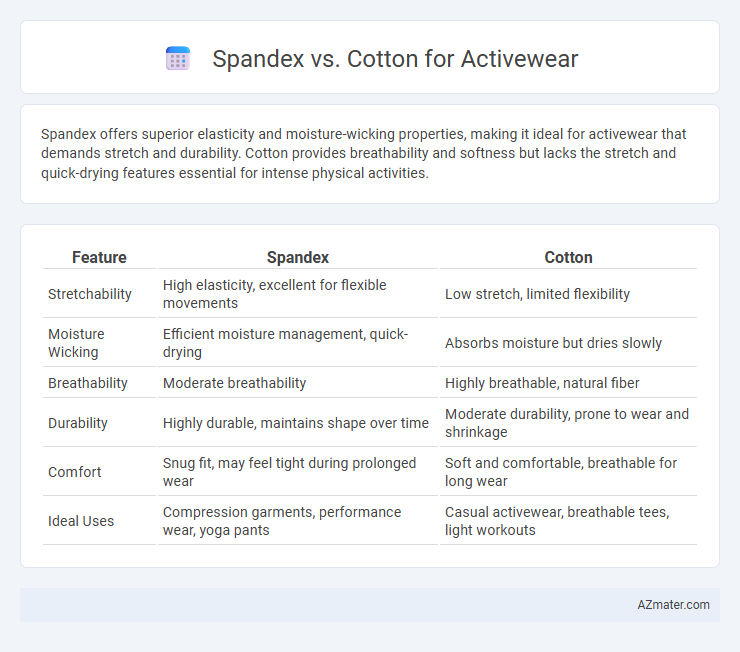Spandex offers superior elasticity and moisture-wicking properties, making it ideal for activewear that demands stretch and durability. Cotton provides breathability and softness but lacks the stretch and quick-drying features essential for intense physical activities.
Table of Comparison
| Feature | Spandex | Cotton |
|---|---|---|
| Stretchability | High elasticity, excellent for flexible movements | Low stretch, limited flexibility |
| Moisture Wicking | Efficient moisture management, quick-drying | Absorbs moisture but dries slowly |
| Breathability | Moderate breathability | Highly breathable, natural fiber |
| Durability | Highly durable, maintains shape over time | Moderate durability, prone to wear and shrinkage |
| Comfort | Snug fit, may feel tight during prolonged wear | Soft and comfortable, breathable for long wear |
| Ideal Uses | Compression garments, performance wear, yoga pants | Casual activewear, breathable tees, light workouts |
Introduction to Spandex and Cotton in Activewear
Spandex is a highly elastic synthetic fiber known for its exceptional stretch and recovery, making it ideal for activewear that requires flexibility and shape retention. Cotton, a natural fiber, offers breathability and softness, providing comfort during light to moderate physical activities. Activewear blends often combine spandex and cotton to balance moisture-wicking capabilities with durability and comfort.
Key Differences Between Spandex and Cotton Fabrics
Spandex offers exceptional stretch and shape retention, making it ideal for activewear that requires flexibility and durability during high-intensity workouts. Cotton, while breathable and soft for comfort, lacks the elasticity and moisture-wicking properties crucial for performance wear, often leading to slower drying and reduced mobility. The key differences center on spandex's synthetic, elastic nature versus cotton's natural, absorbent fibers, impacting breathability, stretch, and moisture management in athletic apparel.
Moisture-Wicking Abilities: Spandex vs Cotton
Spandex excels in moisture-wicking abilities by quickly drawing sweat away from the skin and promoting faster evaporation, keeping the body dry during intense workouts. Cotton absorbs moisture but retains it, leading to a damp and heavy feeling that can cause discomfort and chafing during physical activity. For activewear, spandex's superior moisture management makes it ideal for maintaining comfort and enhancing performance in both high and low-intensity exercises.
Breathability and Comfort Comparison
Spandex offers superior stretch and moisture-wicking properties, enhancing comfort during high-intensity workouts, while cotton provides natural breathability but tends to retain sweat, leading to clinging and dampness. Cotton's softness ensures comfort for low-impact activities, but its limited airflow reduces drying speed compared to spandex blends designed for activewear. Optimal activewear often combines spandex and cotton to balance breathability and comfort, delivering flexibility with moisture management.
Flexibility and Stretch: Which Excels?
Spandex outperforms cotton in flexibility and stretch due to its exceptional elasticity, allowing activewear to move seamlessly with the body during intense workouts. Cotton lacks the same stretch capacity, often leading to restricted movement and loss of shape over time. For high-performance activewear, spandex-infused fabrics offer superior recovery and comfort, making them the preferred choice for flexibility.
Durability and Longevity in Activewear
Spandex offers superior durability and stretch retention compared to cotton, making it ideal for high-intensity activewear that requires flexibility and resistance to wear and tear. Cotton, while breathable and comfortable, tends to lose shape and degrade faster when exposed to frequent washing and rigorous movement. Activewear blending spandex with cotton balances longevity and comfort, extending garment lifespan while maintaining soft, breathable qualities.
Hypoallergenic and Skin Sensitivity Factors
Spandex, known for its elasticity and moisture-wicking properties, is generally less hypoallergenic compared to cotton, which is naturally breathable and gentler on sensitive skin. Cotton's natural fibers reduce irritation and are ideal for individuals with skin sensitivities or allergies, making it a preferred choice for activewear targeting hypoallergenic needs. While spandex blends enhance flexibility and fit, pure cotton fabric remains superior in minimizing skin reactions during prolonged physical activity.
Maintenance and Care: Easy or Demanding?
Spandex activewear requires gentle washing in cold water and air drying to maintain elasticity and prevent fabric breakdown, making its maintenance moderately demanding. Cotton activewear, while breathable and natural, often shrinks or loses shape after washing, necessitating careful heat management during laundering and drying. Both fabrics benefit from mild detergents, but spandex demands more specialized care to sustain performance and durability.
Environmental Impact: Spandex vs Cotton
Spandex production relies heavily on non-renewable petroleum-based resources and emits significant greenhouse gases, contributing to environmental pollution, while cotton cultivation requires extensive water usage and often involves pesticide application that can harm ecosystems. Organic cotton reduces chemical inputs but still demands large water volumes, whereas recycled spandex offers a more eco-friendly alternative by minimizing waste and resource consumption. Choosing sustainable fibers like organic cotton or recycled spandex is crucial to lowering the ecological footprint of activewear manufacturing.
Choosing the Best Fabric for Your Fitness Needs
Spandex offers superior stretch and flexibility, making it ideal for high-intensity workouts that require a full range of motion, while cotton provides breathability and natural moisture absorption, perfect for low-impact activities and casual wear. Choosing the best fabric depends on your fitness routine's intensity, with spandex enhancing performance in yoga, running, or cycling and cotton ensuring comfort during walking or light gym sessions. Prioritizing moisture-wicking capabilities and durability can further optimize your activewear selection for sustained comfort and support.

Infographic: Spandex vs Cotton for Activewear
 azmater.com
azmater.com